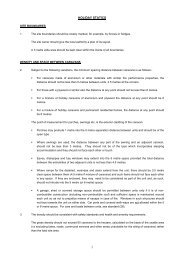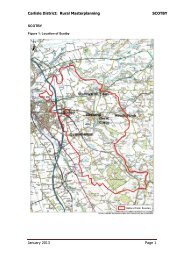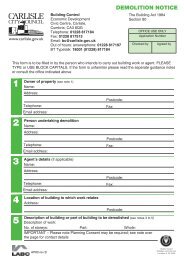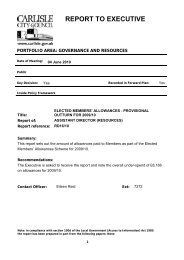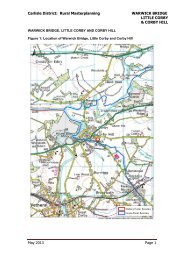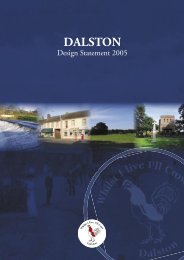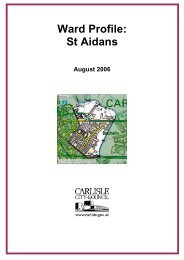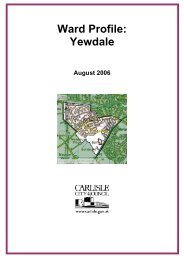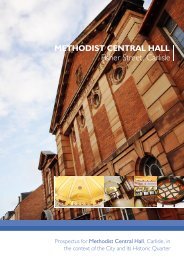Carlisle District Local Plan.indd - Carlisle City Council
Carlisle District Local Plan.indd - Carlisle City Council
Carlisle District Local Plan.indd - Carlisle City Council
You also want an ePaper? Increase the reach of your titles
YUMPU automatically turns print PDFs into web optimized ePapers that Google loves.
<strong>Carlisle</strong> <strong>District</strong> <strong>Local</strong> <strong>Plan</strong> 2001 - 2016 Revised Redeposit draft6.14 The importance of sites such as these has become significantly greater in recent years asopportunities to study the earth’s history through its rocks, fossils, minerals and landformsare rapidly disappearing because of changes in land use and the pressure of development.6.15 In view of their importance, development or land use changes which would adversely affectthese sites will not be permitted. Sensitive development may however be possible, providingthat it preserves the value of the site. At some sites there may be benefits of furtherexposing the features which make them important. The <strong>City</strong> <strong>Council</strong> therefore supports theenhancement, access and interpretation of sites where appropriate.6.16 The <strong>Plan</strong> area includes a number of RIGS as indicated on the Proposals Map, althoughmore are likely to come forward within the <strong>Plan</strong> period. Sites can range from thoseinfluenced by man such as rock exposures in old quarries to the natural forces driving rivererosion. The Cumbria RIGS Group hold information on these sites.6.17 In addition to SSSIs, there are a large number of other important nature conservation sitesin the <strong>Plan</strong> area, which do not meet the criteria used by English Nature to assess potentialSSSIs. These sites have been designated by the Cumbria Wildlife Trust as wildlife sites. Theyare examples of important habitats with uncommon species of plants and animals. As withSSSIs, the sites vary considerably in size and character from large woodlands, areas ofwetland, moorland and heath and small areas of roadside verge. Within the built up areaof <strong>Carlisle</strong> such sites include the Caldew Valley, Cummersdale Holmes, Tarraby Lane andEngine Lonning areas, Kingmoor Sidings and Kingmoor Nature Reserve, which is the oldestreserve in the <strong>District</strong>, being designated in 1914. It consists of approximately 40 hectares ofprotected woodland and fields. The <strong>City</strong> <strong>Council</strong> manages the reserve and will continue toseek to enhance the habitats and nature trails of this valued recreational and educationalasset, through the drawing up of a detailed management plan for the area.6.18 The Cumbria Wildlife Trust provides updated information on Wildlife Sites on a variety ofmatters including location, flora and fauna, etc. The Cumbria Wildlife Trust, in conjunctionwith the <strong>City</strong> <strong>Council</strong>, will seek to undertake further surveys of the area in order to designateadditional sites under this Policy.6.19 The importance of sites such as these has become significantly greater in recent years, aschanging agricultural practices and the disappearance of traditional management in thecountryside have resulted in the loss or alteration of many sites. Many species of plants andbutterflies which were common fifty years ago are now found only rarely.6.20 In view of their importance, it is considered that development or land use changes whichwould adversely affect the nature conservation importance of these sites should not bepermitted unless there is an overriding need. Such changes could include moorlandafforestation or lack of sensitive management of important woodlands, as well asdevelopment requiring planning permission. Where derelict land reclamation schemes areproposed, undisturbed areas which are significant from a nature conservation point of viewshould be respected. Where development is permitted which would result in the loss of anenvironmental feature such as woodland, there will be a requirement to replace this featurein an appropriate location.6.21 Article 10 of the Habitats Directive and the associated regulations state that <strong>Local</strong> <strong>Plan</strong>sshould include Policies encouraging the management of features of the landscape whichare of major importance for wild flora and fauna. These features are those which, becauseof their linear and continuous nature or their function as stepping stones, are essentialfor migration, dispersal and genetic exchange. Such features could include rivers with100 September 2006



